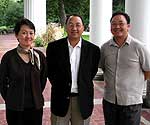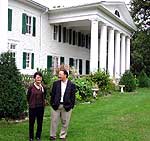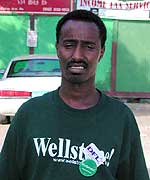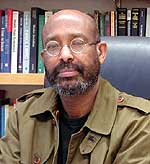By Art Hughes
Minnesota Public Radio
September 17, 2002
New data from the U.S. Census show Minnesota's Asian population is economically well-off compared to other minority populations in the state. While the '90s were a prosperous time for Minnesota as a whole, the numbers show many minority groups did not prosper as much as their white neighbors.
The new round of figures also pinpoints the number of Somalis in the state for the first time. The figure mirrors other official estimates, but is much lower than what some Somali leaders say.
| |
|
|
|
||
Tru Thao laughs as he recalls a picture from just after he arrived in the U.S. during the refugee resettlement efforts of the mid-1970s. In the picture he and his brother, Xuoa, stand smiling in front of a statue of Abraham Lincoln in a Providence, R.I. park. They didn't know it at the time, Tru says, but the coats both men are wearing were meant for women.
"It was nice and warm," Tru Thao says. "We didn't care if it was man or woman. It was nice and warm for us."
Tru Thao, a licensed counselor, says it takes a while for each immigrant group to adapt to their new surroundings.
"I have a client come to see me in December with sandals. Somebody's going to say, 'Is this client stupid or what?' They're not stupid. They're just not in tune to the way of life here. If it's clean, they think it's nice and clean. They don't think that the cold, wind chill below 40s is blowing right through. That's integrating the mind to life here," says Tru Thao.
Now both men sit in the dining room of the Cedarhurst mansion in Cottage Grove. The brothers bought the 26-room historic house about a year ago. They rent it out while restoring it, with the help of Xuoa's wife See Vang Thao.
| |
|
|
|
||
They moved to Minnesota in 1996. All three are professionals who serve primarily Minnesota's Hmong population. Xuoa Thao says like the Scandanavians, Germans, Irish and other immigrants before them, the Hmong are eager to write the next page of Minnesota's history.
"It's a great country. We love it tremendously. But we feel our obligation is to do exactly what our predecessors from other lands have done - come here, build a family, love other people, roll up our sleeves, contribute back and make this country move forward," says Xuoa Thao.
The latest round of numbers from the 2000 census shows the Thaos and others in the general category of Asians proved to be well ahead of other minorities in the state. They reported an annual median income of nearly $46,000 per household. Only Minnesota's non-Hispanic white population had a higher household income of more than $48,000.
And, as they did in 1990, Asians have a higher median home value than any category, including whites. The state's overall median home value is $118,000.
But there are struggles in the Asian community as well. The poverty rate for Asians is more than double that for the state as a whole. And there was a slight increase during the 1990s in the percentage of Asian high school dropouts.
| |
|
|
|
||
The state's other minorities fair even worse.
Household incomes for Hispanics didn't reach $36,000 - more than $11,000 below the state as a whole. For blacks, the number is less than $29,000. And despite the influx of cash from casinos, income in the American Indian category stayed below $28,000, and 29 percent of the state's Native Americans live in poverty.
"They made some good strides in the '90s, but they had such a long ways to go that they're still way behind the majority," says Barbara Ronningen, a research analyst with the State Demographic Center.
Ronnigen says incomes did rise for for the state's Native Americans, but pervasive poverty continues to drag the racial group down. She says the state's Hispanic population exploded during the '90s, but they continue to work low-skilled service jobs that slow their overall economic growth.
"Landscaping, the lower end of the construction industry like roofing. In greater Minnesota you see meatpacking. Food processing in general is a lower-paid manufacturing job. In part you're seeing that and in part it's because so many of them came in the 1990s," Ronnigan says.
| |
|
|
|
||
The percent of residents in poverty is much higher for all minorities. Twenty-seven percent of blacks and 20 percent of Hispanics remain below the poverty line defined by the federal government. For whites, the number is six percent.
The numbers are from the latest release by the U.S. census, taken from what's known as the long form that one in six people filled out.
In addition to income and housing information, this round of data includes for the first time those Minnesotans who consider themselves Somalis.
If you go to the Cedar-Riverside area of Minneapolis you get the picture of a thriving Somali community. Shops offer specially prepared meat, and pre-paid phone cards that say 'Hello Africa." Outside the Afrik Grocery, Mohamaud Hassan pauses to give his estimates of the population.
"Those coming to Minneapolis, Minnesota are about 70,000," Hassan guesses.
In recent years, Somali leaders have quoted wildly varying numbers ranging upwards from 30,000. The census says the official number of Somalis in the state is not quite 11,200.
Analyst Barbara Ronningan says immigrant numbers are nearly always hard to pin down. In the case of Somalis, there are no accurate counts from the 1990 census and the population is very mobile. She says it's easy to overestimate.
"It's a lay person's number. It's based on 'I see so many Somalis in St. Paul,' or something like that," says Ronnigan. "I would suggest that when you see members of a population that look different than you do, you overestimate their numbers. I think that's been true of other racial or ethnic minorities as well."
Ronningan holds out the possibility of an undercount, but notes the census came very close to estimates she made after counting the number of Somali language speakers in the schools. She says about 3,700 immigrants have come to the state since the census was taken two and a half years ago.
Ahmed Samatar, Macalaster College dean of international studies, says one reason for the wide discrepancy may be that, without a similar service in Somalia, the new immigrants have little practice counting themselves outside of their own family.
"That kind of a cultural context ... drags, even when one is in a different kind of environment like the United States," says Samatar. "The idea therefore that one can wing the numbers out of one's head with some guess - sometimes very intellegent and maybe decently reliable - but most of the time it's still a guess."
Samatar does say many Somalis are new, and either mistrust the census or don't consider it important enough to fill out.
The release of the census' Somali count probably won't put the debate to rest, since policy makers use the numbers for everything from money for housing to placement of medical clinics.
More from MPRMore Information




